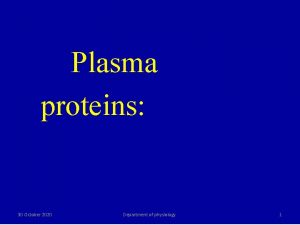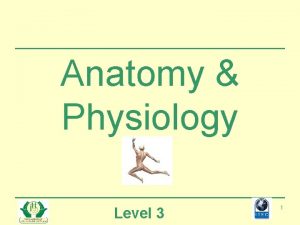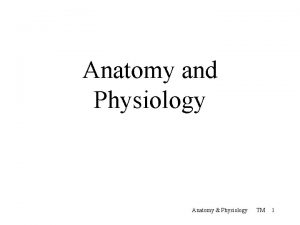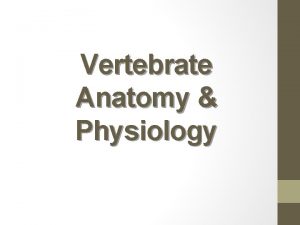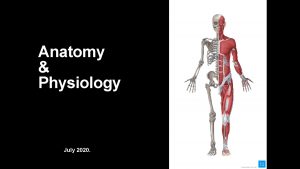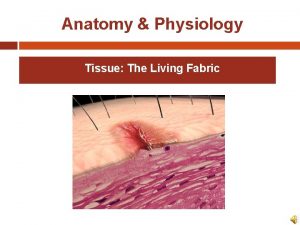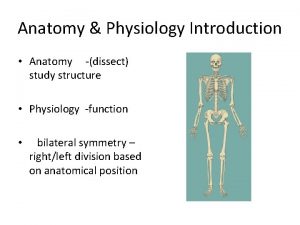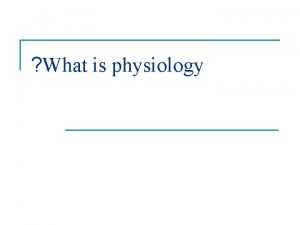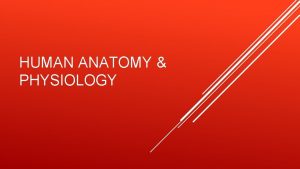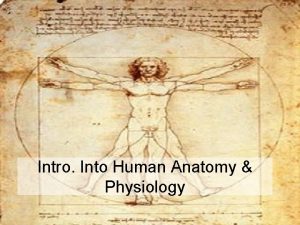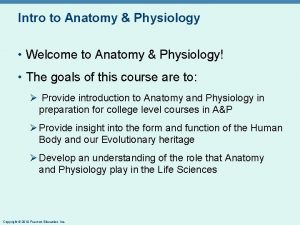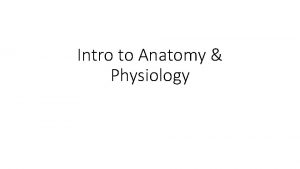Applied Anatomy and Physiology 1 1 a The

































- Slides: 33

Applied Anatomy and Physiology

1. 1. a. The Structure and Function of the Skeletal System Cranium LEARNING OUTCOMES Pelvis By the end of this topic you should … • • • Phalanges Know the name and location of bones in the human body. Be able to describe the 6 functions of the skeleton. Know the definition of a synovial joint. Know hinge joints and ball and socket joints Know the types of movements at hinge and ball and socket joints. Know the roles of ligaments, cartilage and tendons.

Know the location of the major bones The adult skeleton has 206 bones and provides the framework for all movement. PRACTICAL TASK: Using the Labels and marker pen on your table, can you identify the location of the major bones on your ‘designated dummy!’ You need to know the location of the following bones: • Cranium • Phalanges • Vertebrae • Pelvis • Ribs • Femur • Sternum • Patella • Clavicle • Tibia • Scapula • Fibula • Humerus • Tarsals • Ulna • Metatarsals • Radius • Carpals • Metacarpals

Know the location of the major bones So How did we do? ! Who will be the winning table! For each bone you correctly label you will earn yourself a point! Most points WIN!

Know the location of the major bones Head/Neck joint Cranium Vertebral column

Know the location of the major bones Shoulder joint Scapula Humerus Clavicle

Know the location of the major bones Chest region Ribs Sternum

Know the location of the major bones Elbow region Humerus Radius Ulna

Know the location of the major bones Hip joint Femur Pelvis

Know the location of the major bones Femur Patella Knee joint Tibia

Know the location of the major bones Fibula Tibia Talus Ankle joint

Know the location of the major bones Bones of the HAND Bones of the FOOT

Know the location of the major bones And Our Winners Are!

Main functions of the skeleton How might we remember these? https: //www. youtube. com/watch? v=a. UHh 8 u. Md. Bso Did you get these? 1. To give Posture and Support to the body 2. To allow Movement of the body 3. To give Protection to the internal organs 4. To produce Blood (White and Red) Cells 5. To Store Minerals

Main functions of the skeleton 1. Support It gives the body support, enabling us to stand. The bones of the body are held together by ligaments. The skeleton provides a framework for the muscles, which are attached to bones by tendons. 2. Protection Some of our body parts, such as the brain, are very delicate and need protection. Bones can protect body parts from impacts and injuries. What vital organ does the Cranium protect? What vital organ does the Rib Cage protect?

Main functions of the skeleton 3. Movement The skeleton has many different joints. At joints, muscles and bones form levers to allow sporting movements. 4. Posture & Structural Shape The skeleton acts as a framework. Muscles are firmly attached to bones forming our body shape and holds us upright.

Main functions of the skeleton 5. Mineral Storage The minerals in your bones serve two main functions. Minerals transform spongy bone matrix into a rigid structure and in turn increase density and strength. Your bones also function as a mineral storage depot, releasing dissolved calcium, phosphorus and magnesium into your bloodstream when needed.

Main functions of the skeleton 6. Blood cell production The ends of long bones and some other bones including the ribs, humerus, femur and even vertebrae bones, contain red bone marrow. This is where the red blood cells are produced which carry oxygen. Other functions include:

Types of synovial joint Structure of the skeleton “A joint is a place where two or more bones meet” The skeletal system has a number of joints which are responsible for the huge range of movement. There are several different types of joint in the body which allow different types of movement. These different Type of Joint include:

Types of synovial joint Synovial Joints https: //www. youtube. com/watch? v=0 c. Yal_hitz 4 A Synovial Joint is a freely movable joint in which the bones surfaces are covered by cartilage, called Articular Cartilage, and connected by a fibrous Cartilage connective tissue capsule lined with Synovial Fluid You Need to Know This!

Types of synovial joint (hinge joint) Hinge Joints Only allow flexion and extension movement like the hinge on a door. Examples found in the body are the knee and elbow joints Why are these joints important for sport? These joint are extremely powerful and in conjunction with surrounding muscles can produce power and speed i. e. Knee drive during a 100 m sprint The Articulating bones are bones that move within a joint, for example the Articulating bones for the elbow joint are: 1. Humerus 2. Radius 3. Ulna

Types of synovial joint (hinge joint) Hinge Joints You need to know the make up of the Knee and Elbow Joints.

Types of movement at hinge joints Movement at A Hinge Joint FLEXION – Decreasing the angle at a joint. (Bending the leg at the knee joint) Flexion EXTENSION - Increasing the angle at a joint. (Straightening the leg at the knee joint) Extension TASK: Describe a specific sporting example of both Flexion and Extension at both the Knee and the Elbow.

Types of synovial joint (ball and socket) Ball & Socket Joints You need to know the make up of the Shoulder and Hip Joints. Humeral Head Femoral Head (ball) Acetabulum Glenoid cavity (socket)

Types of synovial joint (ball and socket) Ball & Socket Joints You need to know the make up of the Shoulder and Hip Joints.

Types of movement at ball and socket joints Ball & Socket Joints Where the rounded end of one bone fits inside the cup-shaped end of another bone. Ball and socket joints allow movement in all directions. These are the most mobile joints in the body. Examples found in the body include the shoulder and hip joints. Why are these joints important for sport? Most sporting movements require the type of movement the shoulder and hip allow. i. e. tennis serve

Types of movement at ball and socket joints Movement at a Ball & Socket joint Flexion and Extension: Increasing and decreasing the angle at the joint. Abduction and Adduction: determined from the ‘MIDLINE’ of the body. Abduction Adduction

Types of movement at ball and socket joints Adduction & Abduction ADDUCTION – Sideways moving limb towards midline of the body. REMEMBER: Adduction is to ADD towards the midline. ABDUCTION – Sideways moving limb away from midline of the body REMEMBER: Abduction is to TAKE AWAY from the midline.

Types of movement at ball and socket joints Movement at a Ball & Socket joint Rotation/Circumduction: The joint moves in a circular motion. e. g. Service action or bowling action. Let’s See if you Fully Understand TASK 1: Draw and describe a simple diagram of the Knee Joint and label the bones that move around this (the Articulating Bones) TASK 2: Name a Physical Activity that involves both Flexion and Extension of the Knee Joint TASK 3: Draw and describe a simple diagram of the Hip Joint and label the bones that move around this (the Articulating Bones) TASK 4: Describe a skill in a physical activity that involves both abduction and adduction of the hip joint.

Other components of joints Structure of a synovial joint

Other components of joints Structure of a synovial joint YOU NEED TO KNOW THESE! Ligaments: Bands of connective tissue that connect bone to bone & stabilise moment. Cartilage: Designed to reduce friction and act as a shock absorber for the joint Synovial fluid: Acts like an oil and lubricates the joint. Tendons: Attach Muscle to Bone (example - Achilles tendon) A Synovial Joint is a freely movable joint in which the bones surfaces are covered by cartilage, called Articular Cartilage, and connected by a Cartilage fibrous connective tissue capsule lined with Synovial Fluid

Apply your knowledge TASK: USE YOUR KNOWLEDGE OF THE SKETAL SYSTEM TO LABEL AS MUCH INFO AS POSSIBLE ON THE ATHLETE BELOW. (BONES / JOINTS /MOVEMENT ACTIONS).

OCR Resources: the small print OCR’s resources are provided to support the delivery of OCR qualifications, but in no way constitute an endorsed teaching method that is required by the Board, and the decision to use them lies with the individual teacher. Whilst every effort is made to ensure the accuracy of the content, OCR cannot be held responsible for any errors or omissions within these resources. Our documents are updated over time. Whilst every effort is made to check all documents, there may be contradictions between published support and the specification, therefore please use the information on the latest specification at all times. Where changes are made to specifications these will be indicated within the document, there will be a new version number indicated, and a summary of the changes. If you do notice a discrepancy between the specification and a resource please contact us at: resources. feedback@ocr. org. uk. © OCR 2018 - This resource may be freely copied and distributed, as long as the OCR logo and this message remain intact and OCR is acknowledged as the originator of this work. OCR acknowledges the use of the following content: • • • • 3, 5 -11 > Skeleton / stihii / Shutterstock. com 12 > Hand / La Gorda / Shutterstock. com 12 > Foot / corbac 40 / Shutterstock. com 15 > Foot / Sebastian Kaulitzki / Shutterstock. com 15 > Skull with brain / kavring / Shutterstock. com 15 > Brain / maglyvi / Shutterstock. com 15 > Heart / Bernardo Ramonfaur / Shutterstock. com 16 > Running skeleton / tose / Shutterstock. com 16 > Sitting skeleton / tose / Shutterstock. com 16, 24, 26 > Shoulder / Designua / Shutterstock. com 16 > Throwing men / Gabriele Maltinti / Shutterstock. com 17, 18 > Bone / ciencepics / Shutterstock. com 17 > Glass Milk / Kenneth Man / Shutterstock. com 19 > Skeleton head / Sebastian Kaulitzki / Shutterstock. com 19 > Rugby player / wavebreakmedia / Shutterstock. com • • • • 20 > Synovial joint / joshya / Shutterstock. com 21 > Knee joint / Sebastian Kaulitzki / Shutterstock. com 21, 26 > Hinge / Aldona Griskeviciene / Shutterstock. com 21, 28 > Rowers / Jaysi / Shutterstock. com 21, 26, 27 > Tennis / Franck Camhi / Shutterstock. com 22 > Elbow joint / Alila Medical Media / Shutterstock. com 22 > Knee / Viktoriia Panchenko / Shutterstock. com 23 > Flexion / Ljupco Smokovski / Shutterstock. com 23 > Extension / Ljupco Smokovski / Shutterstock. com 24 > Hip / Alila Medical Media / Shutterstock. com 25 > Hip / Oleksii Natykach / Shutterstock. com 27 > Outline / Anna Rassadnikova / Shutterstock. com 27, 29 > Abduction / Auttapon Wongtakeaw / Shutterstock. com 28 > Beach ball / Kzenon / Shutterstock. com • • • Please get in touch if you want to discuss the accessibility of resources we offer to support delivery of our qualifications: resources. feedback@ocr. org. uk 29 > Bowler 1 / imagedb. com / Shutterstock. com 29, 31 > Bowler 2 / imagedb. com / Shutterstock. com 29 > Bowler 3 / imagedb. com / Shutterstock. com 30 > Anatomy of the knee / Viktoriia Panchenko / Shutterstock. com 30 > Cartilage / Tefi / Shutterstock. com 30 > Synovial fluid / Blamb / Shutterstock. com 30 > Human Knee / Designua / Shutterstock. com 30 > Tendon / gritsalak karalak / Shutterstock. com 31 > Pushups / Di Studio / Shutterstock. com 31 > Runner / Min. Dof / Shutterstock. com 31 > Football / Valua Vitaly / Shutterstock. com
 Applied physiology
Applied physiology The upper airways
The upper airways Tattoo anatomy and physiology
Tattoo anatomy and physiology Science olympiad anatomy and physiology
Science olympiad anatomy and physiology Incomplete flower
Incomplete flower Bone anatomy and physiology
Bone anatomy and physiology Ulcer definition anatomy
Ulcer definition anatomy Liver anatomy and physiology
Liver anatomy and physiology Epigastric region
Epigastric region Epigastric vs hypogastric
Epigastric vs hypogastric Google
Google Chapter 14 anatomy and physiology
Chapter 14 anatomy and physiology Human anatomy and physiology seventh edition marieb
Human anatomy and physiology seventh edition marieb Http://anatomy and physiology
Http://anatomy and physiology Chapter 1 introduction to human anatomy and physiology
Chapter 1 introduction to human anatomy and physiology Physiology of appendix
Physiology of appendix Aohs foundations of anatomy and physiology 1
Aohs foundations of anatomy and physiology 1 Aohs foundations of anatomy and physiology 1
Aohs foundations of anatomy and physiology 1 Anatomy and physiology of swine
Anatomy and physiology of swine Anatomy and physiology chapter 8 special senses
Anatomy and physiology chapter 8 special senses Chapter 13 anatomy and physiology of pregnancy
Chapter 13 anatomy and physiology of pregnancy Unit 26 agriscience
Unit 26 agriscience Science olympiad forensics cheat sheet
Science olympiad forensics cheat sheet Chapter 2 basic chemistry anatomy and physiology
Chapter 2 basic chemistry anatomy and physiology Physiology of stomach ppt
Physiology of stomach ppt Pancreas anatomy and physiology
Pancreas anatomy and physiology Chapter 7:9 lymphatic system
Chapter 7:9 lymphatic system Anatomy and physiology coloring workbook chapter 14
Anatomy and physiology coloring workbook chapter 14 Chapter 10 blood anatomy and physiology
Chapter 10 blood anatomy and physiology Aohs foundations of anatomy and physiology 1
Aohs foundations of anatomy and physiology 1 Aohs foundations of anatomy and physiology 1
Aohs foundations of anatomy and physiology 1 What produces bile
What produces bile Anatomy and physiology chapter 15
Anatomy and physiology chapter 15 Cornell notes for anatomy and physiology
Cornell notes for anatomy and physiology
